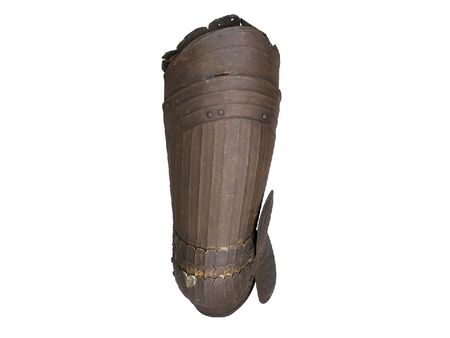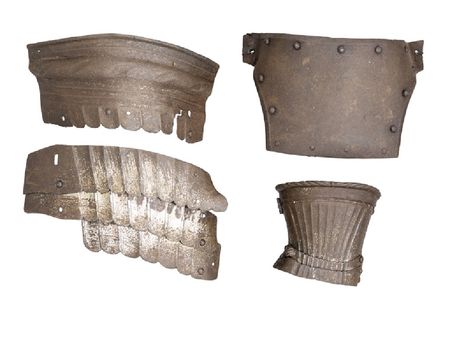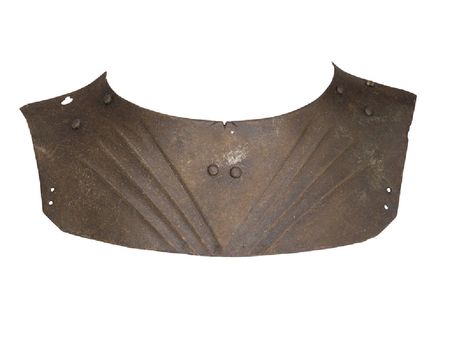The Brunswick Armourers @ The Hanoverian Royal Family and Their Collections
The Brunswick Armourers
With its proximity to the Harz mountains and their wealth of metal deposits Brunswick had been an important metalworking centre as early as the 13th Century. The death of Conrad de platenmekere (the armourer) is recorded in 1320. From surviving documents from 1303 onwards there are increasingly frequent mentions in the old city of the crafts of Helmsleger (helm forger), Platenschleger (armour forger), platenmekere (armour maker) and Harneschmeker (harness maker).
The Brunswick armourers reached their highest standing in the 16th Century when their reputation appears to have extended beyond the borders of Germany, with commissions being received in 1556 for ten etched full armours from Prince Gustav of Sweden and a request for armour from Brunswick was made in 1563 by Jacob, Archbishop of Reuss and Imperial Legate to Poland for service against the Duke of Moscow. In addition to the manufacture of armour there are a number of extant documents recording its decoration by etchers who were members of the painters guild. The production of armour ranged from highly decorated pieces for important patrons through to considerable quantities of simpler pieces for the use of regular troops, which might be left ‘in the white’, blued or decorated in the so-called ‘black and white’ fashion. Much munition armour has been recorded in the arsenals throughout the former Duchy, such as those of Brunswick town, Minden, Celle and Emdem amongst several others. In the past confusion has been created between this latter group of munition armours and those made specifically for the Dukes that might have originally been preserved in the dukes personal Rustkammer (armoury) which was first a part of the residence in Wolfenbüttel, then stored above the library there before being absorbed into the main Zeughaus, located next to the Schloss. The Zeughaus still stands today, an impressive substantial building that now houses part of the Herzog August library.
A north German cuisse for the left leg in the so-called 'Maximilian' fashion, circa 1520-30, probably Brunswick. photo Thomas Del Mar Ltd
formed of a gutter-shaped main plate with an upper extension-plate and a poleyn of five lames with a flat centrally-puckered oval side-wing, decorated throughout with patterns of flutes emphasised by pairs of incised lines, and at their main edges with roped turns accompanied by recessed borders, and later leathers - Estimate: £1200-1500
Exhibited: Almost certainly no. 31 at the Exhibition of Arms, Armour & Militaria lent by H.R.H. The Duke of Brunswick at the Tower of London, April 10th-October 31st 1952.
A pair of very similar cuisses were sold Sotheby's, Marienburg, October 2005, lot 274.
A pair of fluted tassets in the so-called 'Maximilian' fashion, probably Brunswick, circa 1520-30. photo Thomas Del Mar Ltd
each formed of the four lames, the upper fitted with a pair of hinges (incomplete) for attaching to a skirt, decorated throughout with patterns of flutes emphasised by pairs of incised lines, their lower borders embossed with three bands and turned roped edges, and later leathers (2) - Estimate: £800-1200
A German spear, late 15th century. photo Thomas Del Mar Ltd
with triangular blade of flattened-diamond section, stamped with a mark on each side and pierced with three holes on each side at the base, short conical socket fitted with a robust up-turned spike, on an early wooden haft bound with a trellis pattern of leather; 38.5cm; 15 1/8in head - Estimate: £800-1000
Elements of north German armour including a portion of a gauntlet in the so-called 'Maximilian' fashion, circa 1520-30, probably Brunswick. photo Thomas Del Mar Ltd
the gauntlet for the right hand, formed of a short flaring cuff, fitted with a hinged inner plate, and two metacarpal plates; four lames of a long tasset (disarticulated), all decorated with patterns of fluting emphasised by incised lines, and the poll-plate of a chanfron (rusted throughout) (4) - Estimate: £500-700
Literature: Dr. J. Fastenau, Die Waffensammlung, 1910, nos. 32 and 306.
The lowest front plate from a gorget in the so-called 'Maximilian' fashion, circa 1505-10, possibly Brunswick. photo Thomas Del Mar Ltd
pierced with a key-hole slot at the left and fitted with a stud at the right shoulder to attach it to a rear plate, and decorated on each side with three diverging flutes emphasised by pairs of incised lines (rusted) - Estimate: £300-400
A German infantry spear, first half of the 16th century. photo Thomas Del Mar Ltd
with medially-ridged diamond-shaped head tapering to a narrow point (the tip blunted), and conical socket, on an early wooden haft
22.2cm; 8 3/4in head - Estimate: £300-400
For similar examples from this collection see Sotheby's Marienburg, October 2005, lot 249
Note: Each was infected with his love of pageantry and ostentation, which in turn was fuelled by rivalry for Napoleon’s earlier displays in Paris 1821. On his death the throne passed to William IV who was the last monarch to rule the kingdoms of Great Britain, Ireland and Hanover and by who’s death in 1837 (under Salic law) Hanover could only be inherited by the senior male member of the family whereas Great Britain could descend to a female of the main line. Hence the Kingdom of Hanover passed to William IV’s next surviving brother Prince Ernst August, Duke of Cumberland, whilst the British throne went to his deceased elder brother’s only child, The Princess Victoria. Ernst August (1771-1851), the fifth son of King George III was portrayed as a difficult person by his contemporaries and was described by his sister-in-law, Queen Caroline, Princess of Brunswick (1768- 1821), as “absolutely repulsive”. This aside, he was passionate about art and the family collections and as early as 1843 he declared all objects of art in his private collection as a family entailed estate. During the early years of his reign a dispute arose between King Ernst August and his niece, Queen Victoria, about the ownership of valuable and historical family jewels and works of art which his father King George III had given to his mother Queen Charlotte. The King of Hanover claimed a number of objects seen as part of the Hanover throne inheritance but which had been taken to England. Significant state portraits and indispensable items representative of Hanover court culture – for example, the priceless silver furniture of George II – came to London. Negotiations were conducted for the return of these and other valuable items. The outcome was that several pieces were given back to Hanover. When he died in 1851, his military and political contributions were underlined as he lay in state : “Beside the King lay, on silver silk cushions, the Crown and Sceptre of Hanover, his busby and sabre, his English Field Marshal’s staff and the Chains of the Order of the Garter and of St. George”. Ernst August was succeeded as King of Hanover and Duke of Brunswick-Lüneburg by his son George V (1819-1878). In 1843 George married Princess Marie of Saxe- Altenburg, to whom he was devoted and for whom he was later to build Schloss Marienburg. Hanover’s choice to side with Austria in the dispute over the reformation of the German Federation cost them dear and ultimately the Kingdom was annexed by Prussian troops following the battle of Langensalza on 27 June 1866. The Prussian minister, Bismarck took possession of many parts of the family collections, parts of which were later reunited with the exiled family. Prior to this, to protect against further dispossession, many valuable works of art were evacuated from annexed Hanover into safe territory: the Silver Chamber, the Guelph Museum collection and the coin collection were moved to Vienna and other collections to Hietzing in the vicinity of Vienna. George V went into exile in Austria in 1866, where his cousin, Duke William of Brunswick-Wolfenbüttel, lived at Villa Braunschweig. George V died in 1878, while on a visit to Paris, and is buried at Windsor next to his ancestors, the Kings of England and Hanover. His son Ernst August, (1845-1923), Duke of Cumberland and Duke of Brunswick-Lüneburg inherited the Duchy of Brunswick- Wolfenbüttel in 1884 from his cousin Duke William, the second son of Duke Frederick William (1771-1815) and Marie, Princess of Baden. With the Duchy Wolfenbüttel Ernst August also inherited its art collection including the armouries of the Dukes of Brunswick in part from Blankenburg, originated in turn from Wolfenbüttel, as well as the various remnants of arsenals throughout the Duchy, and the ducal and princely gunrooms of both the Dukes of Brunswick and the Kings of Hanover. In 1913, Brunswick again became a sovereign duchy for a brief period following the marriage of the Kaiser’s daughter Viktoria Luise (1892-1980) and Ernst August (III), Duke of Brunswick (1887- 1953). This began to end the troubled history between the house of Hanover and Prussia, and brought about the restoration of the confiscated Hanoverian states. The wedding took place in Berlin in 1913 and marked the last great gathering of European monarchy before the outbreak of World War I. Their only daughter, Princess Frederica (1917-1981) married Paul I, King of the Hellenes (parents of H.M. King Constantine living in exile in London and of H.M. Queen Sophia of Spain). In 1946 their son, H.R.H. Prince George Wilhelm, married Princess Sophia of Greece (1914-2001), sister of H.R.H. Prince Philip, Duke of Edinburgh. Five years after the end of the First World War, Duke Ernst August III was one of the first German regents forced to sign the abdication papers for the state of Brunswick (not for Hanover) a day before the Emperor of Germany abdicated and the Weimar Republic was founded. In 1926, the Hanoverian royal family took up residence in their renaissance castle overlooking the town of Blankenburg in the Harz mountains east of Hanover. Here they lived until 1945, when due to the advancing Red Army in the closing stages of World War II, the family was again obliged to leave the property at Blankenburg and found shelter in Marienburg. An eyewitness account recalls the transport of the collections from Blankenburg to Marienburg by British troops, with armour clad mannequins tied with ropes swaying in the back of army trucks as they descended the Harz mountains. A number of pieces were loaned to the Tower of London exhibition in 1952, many of which are included here. The full account of the location and relocation of the Ducal Armouries and Gewehrkammer of the Dukes of Brunswick and those of the Kings of Hanover is a complex one, not least because of the forced moves inflicted upon the family by the Prussians and two World Wars. There have been a number of sales from this group, most notably by Sotheby’s in October 2005 at Schloss Marienburg, where the arms, armour and militaria comprised almost one thousand lots and were sold for a total of £4,764,0004, which continues to stand as a world auction record for an ancestral collection in this field. The present group includes a number of highlights, such as the guns of George IV and pieces from the distinguished Rüstkammer of Julius, Duke of Brunswick.
Thomas Del Mar Ltd . Antique Arms, Armour & Militaria Sale. Wednesday 8th December 2010

/https%3A%2F%2Fprofilepics.canalblog.com%2Fprofilepics%2F1%2F0%2F100183.jpg)








/http%3A%2F%2Fstorage.canalblog.com%2F44%2F22%2F577050%2F66285653_o.jpg)
/http%3A%2F%2Fstorage.canalblog.com%2F93%2F97%2F119589%2F66078328_p.jpg)
/http%3A%2F%2Fstorage.canalblog.com%2F22%2F94%2F577050%2F65900044_o.jpg)
/http%3A%2F%2Fstorage.canalblog.com%2F01%2F54%2F119589%2F65655636_p.jpg)